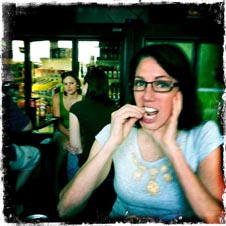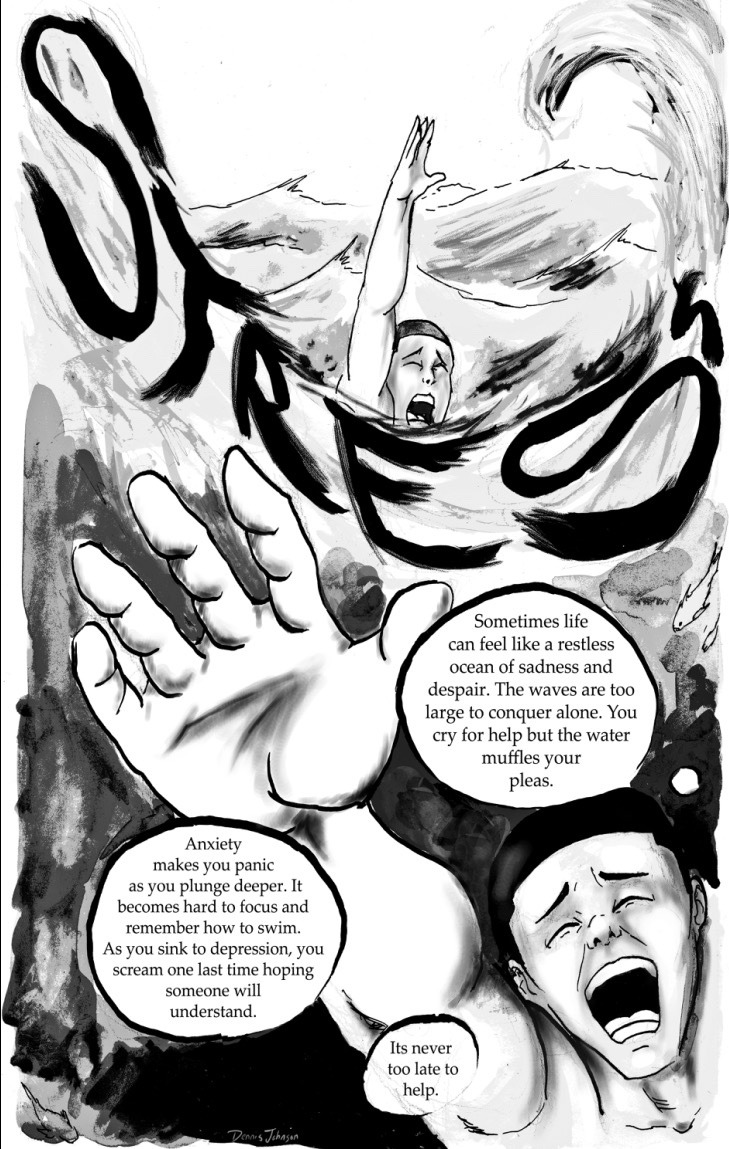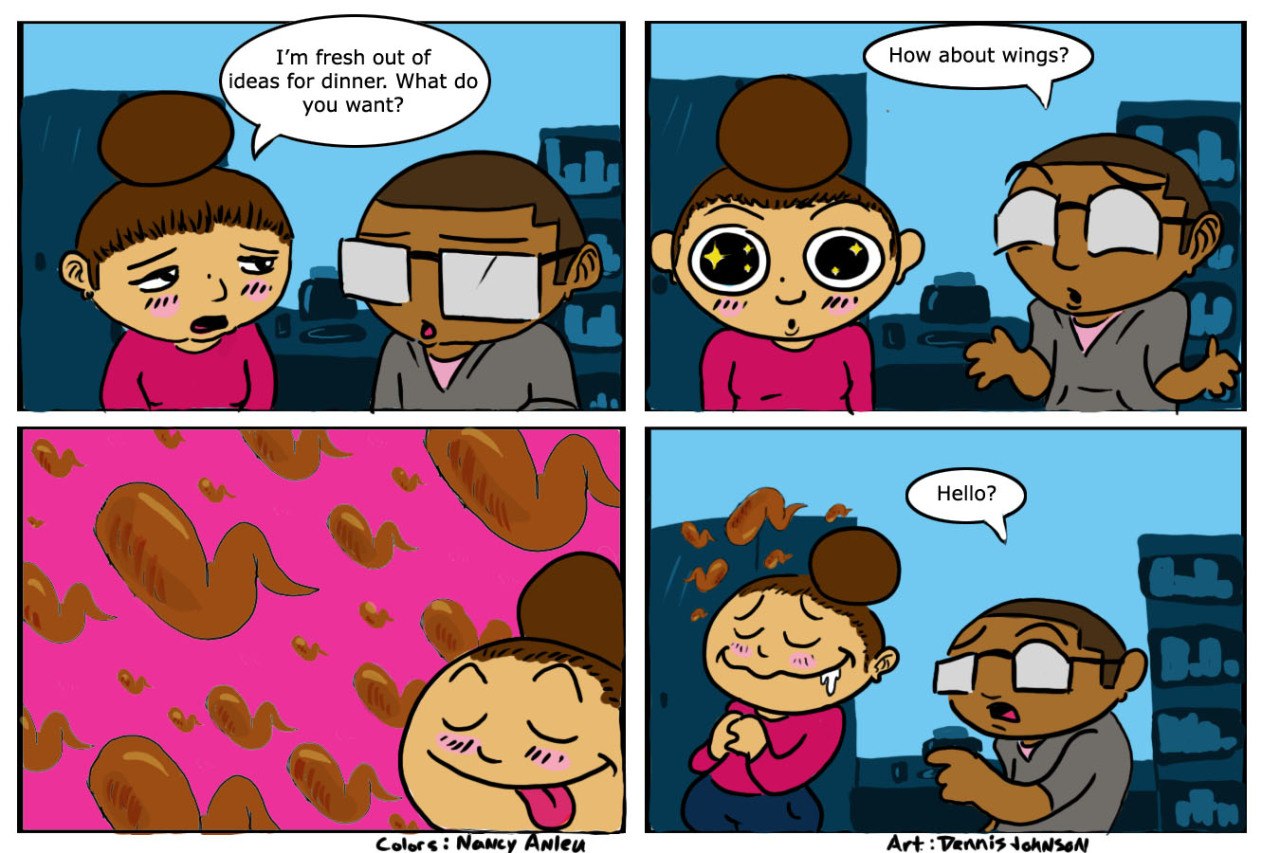Friday, April 03, 2015
Post's ActFour blog on "She Makes Comics" film
Intermission: Joke's on me
By Alyssa RosenbergWashington Post's ActFour blog April 1 2015
http://www.washingtonpost.com/news/act-four/wp/2015/04/01/intermission-jokes-on-me/
PR: Cards, Comics & Collectibles Annual Easter Sale Happening Now
|
| | |||||||||
April 4: Luther Strode signing in Annapolis

Thursday, April 02, 2015
Meet a Local Cartoonist: Dennis Johnson and Dedsquad
 |
| Scott McCloud and Dennis Johnson at Politics and Prose |
Dennis Johnson, Jr. tabled at Smudge with his minicomics last month. I was dashing out to check the parking meter and missed a photograph (so all images are from his blog), but I did buy his minis before leaving. Priorities!
What type of comic work or cartooning do you do?
I am a self-taught artist, and have tried to learn everything about making comics. Currently I am doing a little bit of everything. I am working on writing, drawing, inking, and coloring my own original comics such as “The Ded Squad”, and “The New Frontier.” My stories tend to range from slice of life, to superheroes. I am very versatile, and have also learned other types of art forms such as acrylic painting, and digital art.
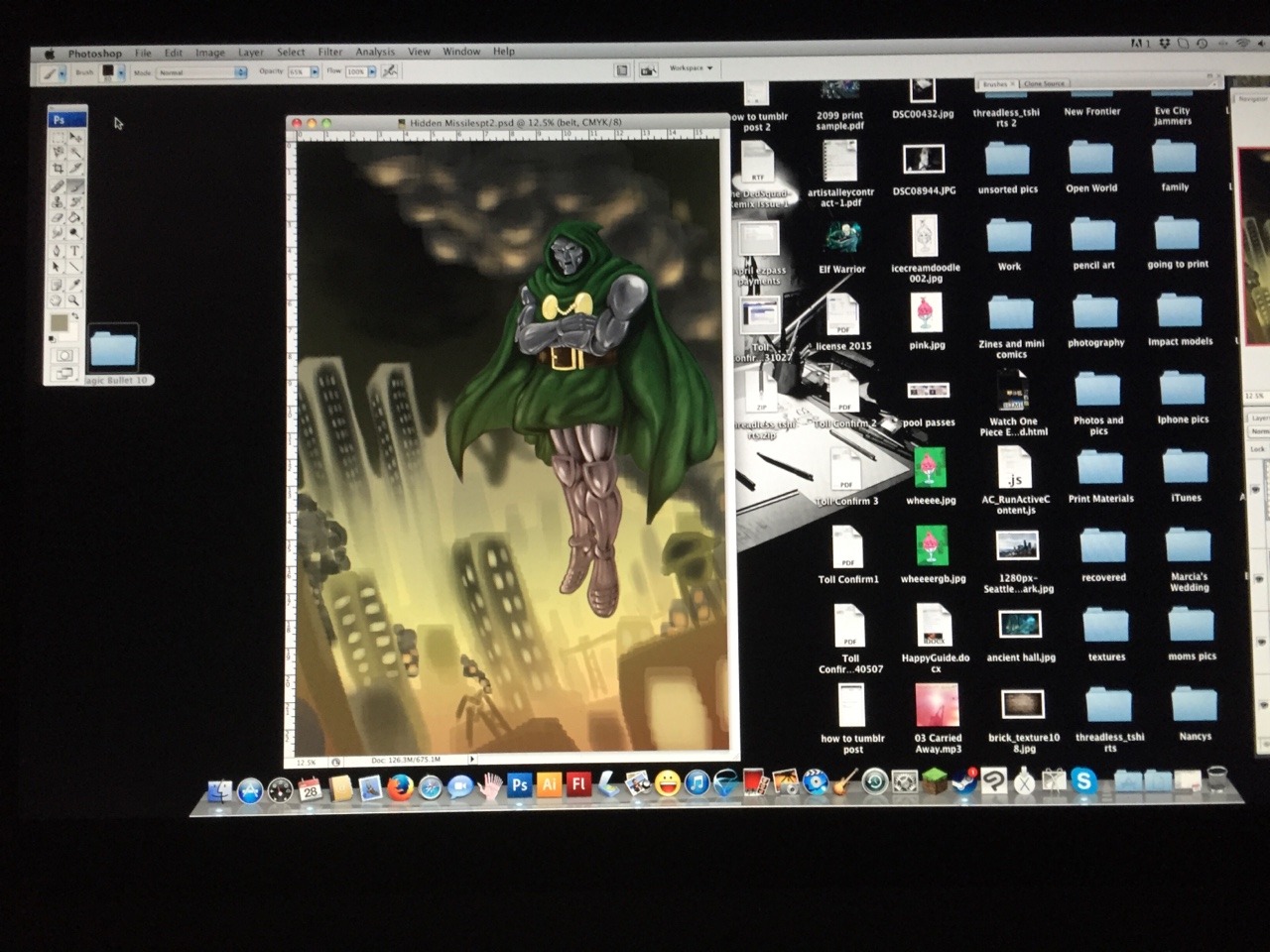 When creating comics I use a combination of techniques but most of the time I start with traditional pencil and paper. I am a huge fan of using brush and ink because the lines come out livelier. Afterwards, I scan my artwork into Photoshop and digitally color it.
When creating comics I use a combination of techniques but most of the time I start with traditional pencil and paper. I am a huge fan of using brush and ink because the lines come out livelier. Afterwards, I scan my artwork into Photoshop and digitally color it.I was born December 6, 1988 in Maryland.
Why are you in Washington now? What neighborhood or area do you live in?
I have lived most of my life in Maryland. Currently I reside in Gaithersburg.
What is your training and/or education in cartooning?
Most of my education in cartooning came from reading and practicing. I never was able to go to school for it so I tried to learn from everything I could get my hands on.
Who are your influences?
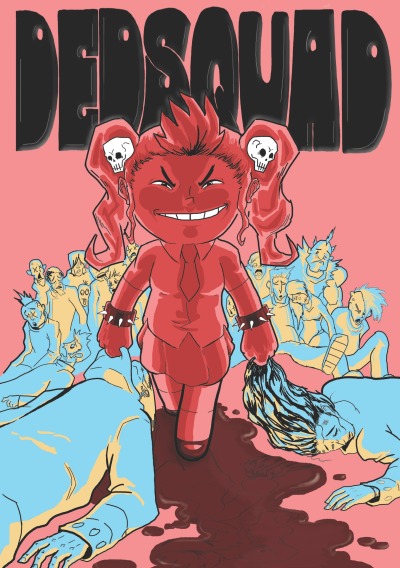
My biggest influence has to be Scott McCloud. He was a crucial part of why I am committed to comics. Through reading many of his books, I realized that comics aren’t just great art or a great story, they are a form of communication. He made me realize that comics are more than just superheroes. After I read his books everything about comics and life just clicked. I also tend to draw inspiration from cartoons, manga, and animated movies.
If you could, what in your career would you do-over or change?
If I could roll back the hangs of time to improve my career I think I would have started to practice making comics earlier. Since I am a self-taught artist, a lot of my work has been trial and error. If I had taken more time to learn more about making comics when I was younger, I could have saved myself a lot of trouble.
Not too long ago I submitted a very personal piece to the 10th edition of the Magic Bullet newspaper. The one-page comic illustrated depression, stress and anxiety to the best of my ability. It was tough for me to write about the pains that I have experienced for years, but the comic turned out to be a great release for me. When it was completed I was so proud of the piece, and it felt like I reached out into the world. Although it did not get accepted, I have displayed the comic at various conventions. I decided that I wanted to connect to those struggling with the same disorder. I feel like this work could really make people think about mental illness and how they can help someone else or help themselves.
What would you like to do or work on in the future?
What's your favorite thing about DC? Least favorite?
I love how diverse the DMV is. D.C. is an amazing place to get to know many different people. My least favorite thing about D.C. is driving. The traffic lights, speed cameras, and one-way roads drive me crazy.
I love to visit the Hirshorn and the National Art Gallery. It’s fun to see the contrast of styles and ideals.
How about a favorite local restaurant?
Do you have a website or blog?
My website is dedsquad.tumblr.com or you can find me on facebook.com/dedinkart.
Comic Riffs on Cartoonists Rights Network
Crowdfund of the week: Free-speech cartoonists vs. legal and mortal threats
By Michael CavnaWashington Post Comic Riffs blog April 2 2015
http://www.washingtonpost.com/news/comic-riffs/wp/2015/04/02/crowd-fund-of-the-week-free-speech-cartoonists-vs-legal-and-mortal-threats/
NoVa's Cartoonists Rights Network International Advocates for Political Artists in Trouble
by Mike Rhode Washington City Paper's Arts Desk blog Mar. 16, 2015
Thompson and Bill Watterson talk comics some more
The Art of Richard Thompson book excerpt: Thompson and Bill Watterson talk comics some more
http://richardspooralmanac.blogspot.com/2015/04/the-art-of-richard-thompson-book.html
Wednesday, April 01, 2015
April 9: Nadja Spiegelman and Sergio Garcia Sanchez
2nd Zodiac Starforce interview online
Magic, Girl Power & Humor Combine to Create "Zodiac Starforce"
Cardner Clark
Comic Book Resources April 1 2015
http://www.comicbookresources.com/article/magic-girl-power-humor-combine-to-create-zodiac-starforce

Dembicki's Wild Ocean listed as a 'Great Environmental Comic'
14 Great Environmental Comics
Nukees goes to Washington
Joe Sutliff's April Fool's day Kickstarter (updated)
Of his 'project,' Joe says, "While easily perceived as a prank, my campaign is (or was) an attempt to tap into the gestalt of crowd funding. Rather that present a complex experience all at once, I wanted to see what would happen if something simple and silly would be appreciated by the community. Now I'm challenged to come up with a response to this. As everyone knows, a wounded cartoonist is the most dangerous beast in the jungle… At least I've become more annoying!"
The Art of Richard Thompson book excerpt: Thompson and Bill Watterson talk comics
 Not a hoax. Not a joke. Not an April Fool's day trick. Here's an excerpt of the conversation of Richard Thompson and Bill Watterson from The Art of Richard Thompson, which you can buy right now from Amazon or Barnes & Noble, or order and wait for a copy signed by Richard from One More Page.
Not a hoax. Not a joke. Not an April Fool's day trick. Here's an excerpt of the conversation of Richard Thompson and Bill Watterson from The Art of Richard Thompson, which you can buy right now from Amazon or Barnes & Noble, or order and wait for a copy signed by Richard from One More Page.BILL WATTERSON: When I was a kid, I loved Peanuts, so I wanted to be the next Charles Schulz. I didn’t understand what that meant of course, but it seemed like a plan. You came to your comic strip from a different path,
however.
RICHARD THOMPSON: Yeah. Off in my own little world of being a pretend cartoonist. Without a plan.
BW: So how did you envision cartooning? What was your experience of it as a kid?
RT: Well, Schulz pretty much defined “cartoonist.” But I remember in fifth grade, a friend’s older sister had some Pogo books and we spent the day poring over them. That was the first time I understood some of the jokes. It was pretty intimidating and dense for a kid.
RT: Yeah, mostly strips. Comic books were hard to find. And a strip is a one-person deal. Not like animation, where you’ve got to work with other people.
BW: As a kid, animation just seemed out of the question to me. I wouldn’t even know how to go about doing it.
RT: It was interesting. But even when I was old enough to maybe try it, I always hated the idea of working with others.
BW: Plus, you needed film equipment and all that.
RT: Yeah. Really, though, I did cartoons without any clear thought of having a future in it.
BW: Any other strips or cartoons that had any impact as a kid?
 RT: Some strange ones. There was a panel called Mr. Tweedy about a hapless little guy. I don't remember who drew it. And there was Freddy by a guy who signed as Rupe. I think he was local.
RT: Some strange ones. There was a panel called Mr. Tweedy about a hapless little guy. I don't remember who drew it. And there was Freddy by a guy who signed as Rupe. I think he was local.BW: I don't know either one.
RT: I think it was probably in one paper. Also, Wizard of Id... BC... And Mad Magazine of course. I discovered that when I was probably ten.
BW: I remember there was some shock value in bringing Mad home.
RT: Right. (laughs) I remember the first time I picked it up in the grocery store and said I wanted to buy this. My parents looked at it and went ickkk. But my dad finally read it and started giggling. He had a good sense of humor, thankfully.
BW: My next-door neighbor bought it regularly, and he'd bring it over and I'd pore over the drawings. Eventually I worked up the nerve to ask my mom if I could get it. There were a number of years when I really thought Mad was the cat's pajamas, although now I think it was pretty formulaic. But even as a kid, it seemed out of the mainstream of cartooning. It was off in its own world.
RT: It seemed to open up this whole subculture.
BW: Could you imagine yourself doing something in that direction?
RT: Kinda vaguely.
 BW: I could never see a way in. I couldn't imagine myself drawing movie and TV satires. I guess Don Martin did the closest thing to a regular cartoon, but in that grotesque style. Or Dave Berg's whatever....
BW: I could never see a way in. I couldn't imagine myself drawing movie and TV satires. I guess Don Martin did the closest thing to a regular cartoon, but in that grotesque style. Or Dave Berg's whatever....RT: The Lighter Side Of (laughs). I'd often read it first. It was always so square!
BW: Right! So what did you respond to in Mad? What aspect?
RT: Oh, the art. The Aragones drawings in the margins and stuff like that. There was no one thing. Spy vs Spy, which was kind of exotic. And of course the parodies, where you discover caricature.
BW: I marveled at Mort Drucker, but I didn't see any road between here and there. At that age, my drawing skills were pretty much limited to drawing things in side-view outlines.
RT: I would try, but... I do remember seeing David Levine drawings of Nixon in like, sixth grade, in my classroom. My teacher was an anti-Nixonite. These beautiful, elegant drawings of Nixon--I remember being fascinated by it. He was using ink like paint, almost.
BW: What, the hatching?
RT: Yeah. So elegant.
BW: I never really responded to Levine. The likenesses were strong, but sort of like stone sculpture, or something- -not warm. I dunno. I remember Oliphant's caricatures really impressed me--so wild and cartoony, compared to Drucker. But getting a likeness is really hard. What made you want to do that?
RT: Caricature was something that'd always interested me. Later, as a freelancer, I thought the more arrows in my quiver the better. When I showed the art director at the Post, Mike Keegan, some pages of caricature sketches, he was delighted. I was suddenly taken more seriously too. I remember the British show Spitting Image had just premiered, and it gave me the kick I needed.
BW: Hm, I'm trying to think what else was in the air back then...
RT: I remember we had a bunch of New Yorker cartoon books in the classroom. This is like fifth or sixth grade. The teacher would bring them from home or something.
BW: OK, you moved in more sophisticated circles than I did!
 RT: I didn't quite understand them. There's a Roz Chast drawing about her as a child finding Charles Addams cartoons, and I remember finding those too, and how gruesome they were. And the painting in them was soft and..
RT: I didn't quite understand them. There's a Roz Chast drawing about her as a child finding Charles Addams cartoons, and I remember finding those too, and how gruesome they were. And the painting in them was soft and..BW: The grays?
RT: Yeah, like no one else.
BW: I was probably a bit older when I saw New Yorkers. You know, if it was a cartoon, I'd jump to read it, but I don't remember them making much impact. Well, actually, I still like George Booth a lot. He's one of the few New Yorker cartoonists whose drawings are funny.
RT: I remember being impressed with New Yorker cartoons, but I probably didn't understand much.
BW: How about comic books? Nothing?
RT: Some. They were hard to find. I'd find them occasionally, and then I'd probably whine 'til I got them. If they were Batmans.
BW: Really, they were hard to find? My town had three drugstores that used to carry them, and I'd get them sometimes, but superhero comics didn't do a lot for me.
RT: Archie and whatnot... I had a few of those but I was never really into them.
 BW: One summer my neighbor gave me this huge box of Archie comic books, and I read them in the car on some family vacation. I have no idea where he got them, but there were a zillion of the things, so my brother and I sat in the back seat reading one after another until it nearly killed us. We read ten thousand Archie comic books and they were all exactly the same.
BW: One summer my neighbor gave me this huge box of Archie comic books, and I read them in the car on some family vacation. I have no idea where he got them, but there were a zillion of the things, so my brother and I sat in the back seat reading one after another until it nearly killed us. We read ten thousand Archie comic books and they were all exactly the same.RT: And the drawings are so clean.
BW: Yeah, very slick. Even then I thought they were dumb and outdated. It's a bizarre memory. How about underground comix? Did they have any impact on you?
RT: Some. I came late to undergrounds. I had friends who collected them (Henry Allen has Zap #0) but my main exposure was all in histories and anthologies. I liked, revered Crumb, though he is overwhelming, and thought Wonder Warthog was freaking hilarious.
BW: I saw some in college and I liked Wonder Warthog too, but on the whole, the undergrounds didn't make much connection. I preferred sillier, more cartoony stuff, I suppose.
What non-cartoon things made an impression on you as a kid?
RT: My folks liked doing things and making me a part of it. I remember when the Mona Lisa came to town. I was about six. We stood in line for a long time. Red draperies and guards every few feet, and then ventually, there it is. My mom liked it a lot. The whole way, she was telling me what an important painting it was and the story of it. She had a great appreciation for culture. She didn’t have any great understanding of it so much as just liked it, I guess.

BW: Wow, I guess you’re one of the few people who’s ever seen it without a foot of bulletproof glass in front of it.
RT: I think so. You couldn’t get right up to it--there were velvet ropes. But you could breathe the same air. (BW laughs)
BW: I don’t remember much exposure to fine art--just the popular culture of the day. I think of my childhood as the Batman TV show, the Beatles, and the moon landings. Although I do remember in middle school there were a few years when I read all the Doctor Dolittle books. I loved those--the idea of talking to animals. A PETA sensibility ahead of its time. It probably had some subliminal influence on my strip. What aspects of pop culture did you participate in?
RT: Well yes, the moon landings and take-offs. You knew it was important when the teacher pushed the TV into the classroom.
Jump over to Richard's Cul de Sac blog for more discussion on comic strips.
Wonder Woman's invisible plane on display at Air & Space Museum today
Wonder Woman's Invisible Jet Now on Display
Beth Wilson
Posted on April 1, 2015 by The National Air and Space Museum
http://blog.nasm.si.edu/behind-the-scenes/wonder-womans-invisible-jet/
https://www.youtube.com/watch?v=ig4aJey9QZMApril 15: Animezing: The Tale of The Princess Kaguya
|
PR: A New Updated ComicBacks list!
From R Bottorff <carchivist@yahoo.com>








